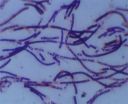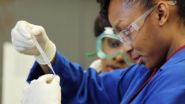(Press-News.org) The much-talked-about Google Glass — the eyewear with computer capabilities — could potentially save lives, especially in isolated or far-flung locations, say scientists. They are reporting development of a Google Glass app that takes a picture of a diagnostic test strip and sends the data to computers, which then rapidly beam back a diagnostic report to the user. The information also could help researchers track the spread of diseases around the world. The study appears in the journal ACS Nano, a publication of the American Chemical Society, the world's largest scientific society.
"It's very important to detect emerging public health threats early, before an epidemic arises and many lives are lost," says Aydogan Ozcan, Ph.D. "With our app for Google Glass and our remote computing and data analysis power, we can deliver a one-two punch — provide quantified biomedical test results for individual patients, plus analyze all those data to determine whether an outbreak is imminent."
Google Glass looks like a pair of eyeglasses without the lenses, but with a small rectangular transparent screen near the right eye that functions as a tiny computer screen. A mouse is built into the right arm of the frame.
Ozcan and colleagues at the University of California, Los Angeles, designed a custom app for Google Glass. The app uses Glass' built-in camera to take a picture of a diagnostic test, called a lateral flow immunochromatographic assay. A familiar example of such an assay is a home pregnancy test.
The wearable computer transmits images of these test strips with their custom-created Quick-Response (known as "QR") code identifiers to more powerful computers in other parts of the world for analysis. Then, a quantified diagnostic result is beamed back to the Google Glass user. If the user is in a remote area without Wi-Fi, then he or she can connect Glass to a smartphone to transmit the data along with geographical information for disease tracking.
In pilot tests, the team successfully used the method with HIV and prostate-specific antigen (known as "PSA") assays. Results were available within eight seconds for each individual test. They could even take a picture of several test strips next to each other in one image and come up with the correct diagnoses.
Other medical diagnostic devices based on smartphone technology, including one recently developed by Ozcan's team, require additional equipment to be attached to the device. Or they require extensive handling of the device and the tests. But the researchers note that their Google Glass set-up works without any external hardware attachments. It is also hands-free, allowing busy technicians to quickly go through many patient tests in a short period.
INFORMATION:
The researchers acknowledge funding from the Presidential Early Career Award for Scientists and Engineers, the U.S. Army Research Office, the National Science Foundation, the Office of Naval Research and the National Institutes of Health.
The American Chemical Society is a nonprofit organization chartered by the U.S. Congress. With more than 161,000 members, ACS is the world's largest scientific society and a global leader in providing access to chemistry-related research through its multiple databases, peer-reviewed journals and scientific conferences. Its main offices are in Washington, D.C., and Columbus, Ohio.
To automatically receive news releases from the American Chemical Society, contact newsroom@acs.org.
Follow us: Twitter | Facebook
Google Glass could help stop emerging public health threats around the world
2014-02-27
ELSE PRESS RELEASES FROM THIS DATE:
Faster anthrax detection could speed bioterror response
2014-02-27
COLUMBIA, Mo. – Shortly following the 9/11 terror attack in 2001, letters containing anthrax spores were mailed to news outlets and government buildings killing five people and infecting 17 others. According to a 2012 report, the bioterrorism event cost $3.2 million in cleanup and decontamination. At the time, no testing system was in place that officials could use to screen the letters. Currently, first responders have tests that can provide a screen for dangerous materials in about 24-48 hours. Now, researchers at the University of Missouri have worked with a private ...
Montreal researchers find a link between pollutants and certain complications of obesity
2014-02-27
Montréal, February 27, 2014 – A team of researchers at the IRCM in Montréal led by Rémi Rabasa-Lhoret, in collaboration with Jérôme Ruzzin from the University of Bergen in Norway, found a link between a type of pollutants and certain metabolic complications of obesity. Their breakthrough, published online this week by the Journal of Clinical Endocrinology & Metabolism, could eventually help improve the prevention, diagnosis, and treatment of cardiometabolic risk associated with obesity, such as diabetes, hypertension and cardiovascular disease.
Although obesity is strongly ...
Battery-free technology brings gesture recognition to all devices
2014-02-27
Mute the song playing on your smartphone in your pocket by flicking your index finger in the air, or pause your "This American Life" podcast with a small wave of the hand. This kind of gesture control for electronics could soon become an alternative to touchscreens and sensing technologies that consume a lot of power and only work when users can see their smartphones and tablets.
University of Washington computer scientists have built a low-cost gesture recognition system that runs without batteries and lets users control their electronic devices hidden from sight with ...
Bisphenol A (BPA) at very low levels can adversely affect developing organs in primates
2014-02-27
COLUMBIA, Mo. – Bisphenol A (BPA) is a chemical that is used in a wide variety of consumer products, such as resins used to line metal food and beverage containers, thermal paper store receipts, and dental composites. BPA exhibits hormone-like properties, and exposure of fetuses, infants, children or adults to the chemical has been shown to cause numerous abnormalities, including cancer, as well as reproductive, immune and brain-behavior problems in rodents. Now, researchers at the University of Missouri have determined that daily exposure to very low concentrations of ...
Household wealth still down 14 percent since recession
2014-02-27
COLUMBUS, Ohio – Household wealth for Americans still has not recovered from the recession, despite last summer's optimistic report from the U.S. Federal Reserve, a new study suggests.
Economists at The Ohio State University found that the mean net worth of American households in mid-2013 was still about 14 percent below the pre-recession peak in 2006. Their analysis suggested that middle-aged people took the biggest hit.
In a report last June, the Federal Reserve said that net worth of Americans – which includes the value of homes, stocks and other assets minus debts ...
IUPUI study reveals how dogs detect explosives, offers new training recommendations
2014-02-27
INDIANAPOLIS— A research team at Indiana University-Purdue University Indianapolis (IUPUI) has helped determine the science behind how canines locate explosives such as Composition C-4 (a plastic explosive used by the U.S. military). The study found the dogs react best to the actual explosive, calling into question the use of products designed to mimic the odor of C-4 for training purposes. These findings are the culmination of a four-year contract funded by the U.S. Department of Defense (DOD).
"Appropriately, dogs that are trained to find real explosives are going ...
Type 1 diabetes: Vitamin D deficiency occurs in an early stage
2014-02-27
Vitamin D is known as a major regulator of calcium levels and bone metabolism. Furthermore, it also influences the immune system. Previous studies have shown that patients with recently diagnosed type 1 diabetes have significantly lower vitamin D levels.
Scientists from the Institute of Diabetes Research (IDF) and the Helmholtz Zentrum München, a member of the German Center for Diabetes Research (DZD), as well as from the Diabetes Research Group at the Technische Universität München (TUM) examined whether a vitamin D deficiency occurs during an early stage of type 1 diabetes, ...
Scientists learn how pathogens hack our immune systems to go undetected
2014-02-27
A new report appearing in the March 2014 issue of The FASEB Journal helps shed light on what drives the evolution of pathogens, as well as how our bodies adapt to ward them off. Specifically, the report shows that our bodies naturally employ a mechanism, called "CD33rSiglecs," that not only dampens unwanted immune responses against one's own cells, but also evolves rapidly to recognize foreign invaders. What's more, the report explains how pathogens exploit this immunological "vulnerability" of "self-recognition" to evade our bodies' defenses. This leads to a seemingly ...
Scientists highlight the importance of nutrients for coral reefs
2014-02-27
A new publication from researchers at the University of Southampton and the National Oceanography Centre, Southampton highlights the importance of nutrients for coral reef survival.
Despite the comparably small footprint they take on the ocean floor, tropical coral reefs are home to a substantial part of all marine life forms. Coral reefs also provide numerous benefits for human populations, providing food for millions and protecting coastal areas from erosion. Moreover, they are a treasure chest of potential pharmaceuticals and coral reef tourism provides recreation ...
Mentoring the next generation of black chemists (video)
2014-02-27
WASHINGTON, Feb. 27, 2014 — The American Chemical Society (ACS) is wrapping up its celebration of Black History Month with a focus on the future. A new ACS video showcases the mentors that are helping shape the next generation of chemists and chemical engineers. The video is available at http://youtu.be/6pX4kmHIeAE.
The video, produced with the National Organization for the Professional Advancement of Black Chemists and Chemical Engineers (NOBCChE), highlights the efforts of Isiah Warner, Ph.D., Boyd Professor at Louisiana State University, to mentor students in the ...





